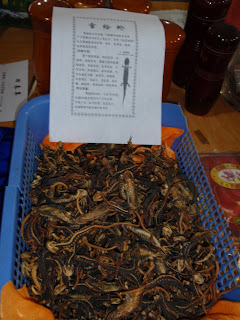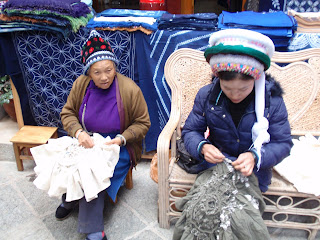
We went on a bus from Lijiang to Dali. The country was wild and beautiful. Small terraced farms dotted all the hillsides. I had to take pictures out of the bus window because the road was narrow and it was impossible to stop. It makes for some interesting photos--note the reflection of the camera.
This area is home to the Bai people. Bai means white so many of the homes, like this one, have white on them. We loved Dali. It is high in the mountains with clear crisp air. Despite the fact thaat we were there in January, much of the land was still green. It is a temperate climate because even though the altitude is high, the latitude is low.
One of the most fascinating things about this area was that many people dressed in the traditional way. This was a lady who was walking by the bus on her way to market.
Dali is located on Erhai Lake. That means Ear Lake because the lake is shaped like an ear. It is a rather large lake and we took a boat trip on it out to see a small island. Here is a boat like the one we took. The trip out was very nice, but by the time we returned a strong wind had come up and the ride home was rather rough--some people were seasick.
As we disembarked this is one of the first scenes that greeted our eyes. I took a series of pictures and have put three of them here. The boat had many large rocks as its cargo. You can see the man on the left has put the chain around the rock. The person on the right is turning a wheel which lifts the rock up--a rather primitive pully system.
Next the rock was hoisted off the boat and onto the land--a very tedious job--and probably a heavy and difficult one as well. You can see the men trying to get the rock to settle lightly? on the ground at the end of the gangplank.
Soon a cart came along, the men hefted the rock onto it and then they wheeled it away. It was a very interesting display.

We turned around from the rock lifting and saw many tables spread with various foods. This is the table which had dried fish on it. Fun to look--but we didn't buy.
As if the fish weren't enough, there were also some dried lizards for sale. We passed on these also.
Back in the town of Dali we visited a tea house. They told us about three kinds of tea--can't find my notes on the details. However, one kind was bitter, one not so bitter and one rather sweet. Each had its distinctive and traditional use. I did not sample them, but their aroma was truly interesting.

While we were waiting for the tea to brew, we were treated to some local entertainment. Young men and women played instruments and sang and danced while wearing some of the local costumes.

We also visited a batik factory--although factory is too glorified a word to describe what we saw. They showed us how they tie up the material and then dye it. After that it is hung out to dry. Eventually when it is completely dry the string is untied and the pattern on the cloth is revealed.
This is a vat of dye and the cloth coming out of it.
The woman on the left is hand tieing the natural material to get it ready to dye. The woman on the right is untieing the cloth after it has been dyed and hung out to dry.
Here is a sample of the cloth that has been partly untied. You can see the flower pattern. We were told it takes weeks to tie the cloth and make it ready to dye--a very interesting and labor intensive procedure. They did have some beautiful table cloths, dresses, scarfs, etc.
 The hotel we stayed in here was the most elegant hotel of our whole trip. The lobby was amazing with carved wood furniture and the bedrooms and bathrooms were like suites--large and beautiful. However, as is the case in all of southern China, there was no heat in the room. So here we were in this elegant hotel, shivering and shaking. We just could not enjoy the place and be as cold as we were. Too bad!
The hotel we stayed in here was the most elegant hotel of our whole trip. The lobby was amazing with carved wood furniture and the bedrooms and bathrooms were like suites--large and beautiful. However, as is the case in all of southern China, there was no heat in the room. So here we were in this elegant hotel, shivering and shaking. We just could not enjoy the place and be as cold as we were. Too bad! Our final view of Dali was of the three pagodas. They are among the oldest standing structures in southwestern China and a sort of symbol of Dali. We did not have time to go into them, but did stop for pictures. A good view for our last one in China as we went to the airport and headed for Viet Nam.











No comments:
Post a Comment